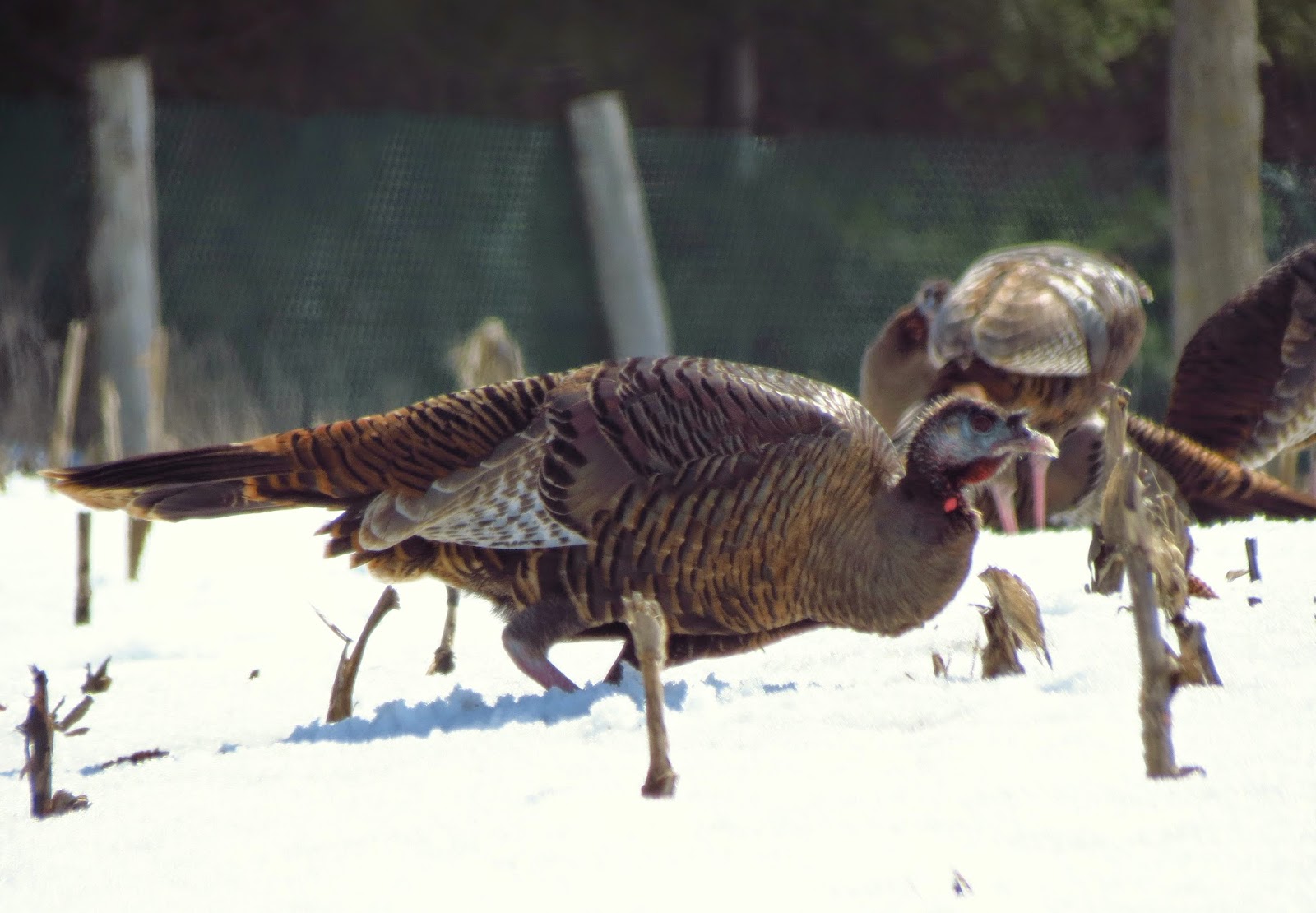5 February 2015
This lone female Hooded Merganser Lophodytes cucullatus has been at the same location on the Conestogo River, just downstream from the weir on Three Bridges Road, for the entire winter.
The flow of the current is especially rapid at this location and this ensures that there is always a little open water in a river that is almost completely frozen by this stage of the winter.
Hooded Mergansers are usually found at the very least in pairs and often in small groups. It is unusual, therefore to see this solitary female.
She is obviously having no trouble finding a ready source of food and she dives into the icy rapids without a moment's hesitation. Often we see her preening and repeatedly immersing herself in the water, all the while vigorously flapping her wings and delicately arranging and sleeking down her feathers.
Sometimes she seems to be content simply to loaf on the ice in a sunny spot, and at this time of the year, with longer days and more strength in the sun's rays, seems to delight in this activity, (if I may be permitted a moment of anthropomorphism).
At this location we have seen an American Mink Mustela vison and I saw it briefly today, but it disappeared into its hole very quickly. On one occasion we watched it cavorting around and swimming across the river, but on that occasion we had no camera with us! We will keep checking to see whether we can get some decent photographs of this individual.
I know that mink have become a serious problem in Europe due to releases and escapes, but here it is an integral part of the ecosystem and is a welcome sight for us.
These horses were patiently waiting at the Mennonite one-room schoolhouse on Martin Creek Road for school to end so that they could return to the comfort of the stable.
Wild Turkeys Meleagris gallopavo are hardy birds and this group was feeding on whatever could be found in a snow-covered field of corn stubble. The temperature was minus 13°.
I am sure that they, like all of us, are looking forward to spring!






























Hello David,
ReplyDeleteThese are great photos of female merganser.
It is very strange that she is alone, perhaps ill ???
Best regards, Irma
Precioso post, y también el de Carolina, me han gustado mucho. Saludos desde España.
ReplyDeleteA lovely log again. Never heard of a Hooded Merganser. I understand it is a sort of duck. Love also the captures of the river with the snow and still streaming water. I am waiting for your captures of the Mink.
ReplyDeleteHave a nice weekend David.
Great shots of the Merganser, she is pretty.. And I love the Wild Turkey shots.. I am definitely anxious for Spring to arrive.. Have a happy weekend!
ReplyDeleteHello David,
ReplyDeleteNice shots of these birds in this winter area. Wonderful.
Best regards,
Marco
Great pictures of the Turkeys and of the Hooded Merganser.
ReplyDeleteHopefully Mr Merganser shows up very soon. Have a nice weekend.
Gr Jan W
Maybe she's making the most of a good site to live for the winter - I would if I was a duck! I've not seen ice just as in the first image so found that interesting too. We're expecting 35C today so -13 sounds really cold!
ReplyDeleteI'll take minus 13 over 35 any day!
DeleteI presume that's the Menonite school bus behind the horse. It seems like such an intriguing glimpse into the life of another community we see regularly, but don't often interact with unless they have a business that we patronize.
ReplyDeleteIn effect, it is.
DeleteYour pictures of the ducks and the Wild Turkeys are fabulous, David. Your shots of the Menonite school and "schoolbus" are so interesting, because we don't have it here. It's almost from "a different world" for me. Fantastic. Have a great weekend. Greetings from the Netherlands, Joke
ReplyDeleteIt does seem unusual that for the usually gregarious merganser family this female should find herself alone. Time will tell if she is able to survive such harsh weather. Just seeing your photos makes me shiver.
ReplyDeleteI think to say that Black Swans are "everywhere" in the UK is something of an overstatement and certainly in our own area I do not know of many feral birds and certainly no breeding population. However the BTO Atlas mentions breeding in over 100 10km squares and breeding pairs in double figures plus a good population in Norfolk.Too cold here in the NW for this Aussie bird?
Barnacle Geese from Greenland and Svalbard winter in the UK where they merge with a growing population of feral birds from escapes etc. That's why there is always a question mark against Barnacles seen amongst the huge flocks of Pink-footed Geese.
Thanks for the information on the Black Swans and the Barnacle Geese.
ReplyDeleteHello David,
ReplyDeleteThe Hooded Merganser rally has weird but gorgeous look!
And wild turkeys have an exquisite plumage!
Great and interesting shots of birds I have yet to see!
The only Wild Turkey I've ever seen came out of a bottle.....................
ReplyDeleteAmazing this woman Merganser. The Netherlands has not and I see them then only in photographs. I think it's a wonderful kind of ducks! But also pictures of the snow is really fantastic to see. I'm afraid we have no more snow in the Netherlands:-(Therefore eht enjoy the photos with snow:-)
ReplyDelete